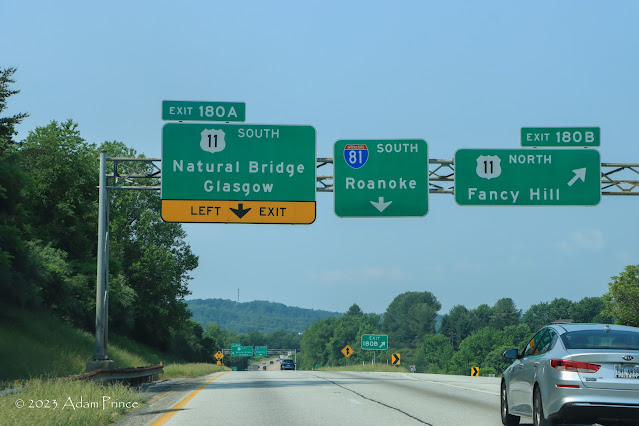 |
| Virginia is for Lovers at the Buchanan Swinging Bridge |
The final day of the road trip saw us head back south and home to Charlotte. However, we did make a few stops, specifically Natural Bridge State Park and the town of Buchanan, Virginia.
Route: I-81, US 11, I-81, US 11, I-581, US 220, I-73, NC 68, I-74, Business I-85, I-85, home.
For the full photo set on flickr - head here.
Traffic wasn't too bad on 81 and the scenery this Sunday morning was very pretty.
 |
| Getting to Natural Bridge State Park from I-81 South involves a unique left-hand exit. |
US 11 was a common theme along I-81 - weaving in and around the Interstate - almost inviting you to take a trip back in time. We exited off the Interstate twice to follow US 11 - to Natural Bridge State Park and then Buchanan.
 |
| Virginia's Natural Bridge State Park |
Natural Bridge is a beautiful site that demonstrates the power and wonder of nature. Privately owned until transferred to the Virginia State Park System in 2016, Natural Bridge State Park features hiking trails, a small natural history museum, a living history exhibit showcasing the life of the Monacan Indians, caves, and waterfalls.
 |
| Keep an eye out for name carvings within the rocks! |
Admission to access the bridge is $9/per person over 13 and $6 for children between 3-12. Admission can be paid either at the Natural Bridge Visitors Center or at the bottom of the gorge at a small ranger/concession stand.
Doug recently wrote a more in-depth feature on Natural Bridge State Park. The park is a pleasant break from the traffic on Interstate 81, and you can easily spend an enjoyable 60 to 90 minutes here.
 |
| It's easy to get back onto the Interstate from Natural Bridge State Park. |
After briefly returning to Interstate 81, we ventured onto US 11 again and into the Town of Buchanan. Buchanan is home to a pedestrian swing bridge over the James River.
 |
| Buchanan Swinging Bridge |
The local landmark dates to 1938 after a new (and still-standing) concrete bridge carrying US 11 over the James River was completed. The Buchanan mayor insisted that a pedestrian connection would continue over the river.
The swinging bridge is one of several existing and former James River crossings at Buchanan since 1851, including three covered bridges and an iron bridge.
 |
| A unique combination of exit letters on Interstate 581 South. |
We got back on the Interstate south of Buchanan. In Roanoke, we headed south on Interstate 581 and US 220 back into North Carolina. Interstate 581 uses the old-style directional exit numbers using N, S, E, and W instead of A&B. Though at Exit 3, there is a 3C, W, and E!
The trip with Colton was great! It was amazing to return to past trips with him. There were some fun memories too. We can't wait to go on our next father-son or full-family adventure!
Site Navigation:
- Civil War Road Trip Day 3 - Gettysburg and More
- Small Towns of Virginia Series - Natural Bridge State Park


Comments